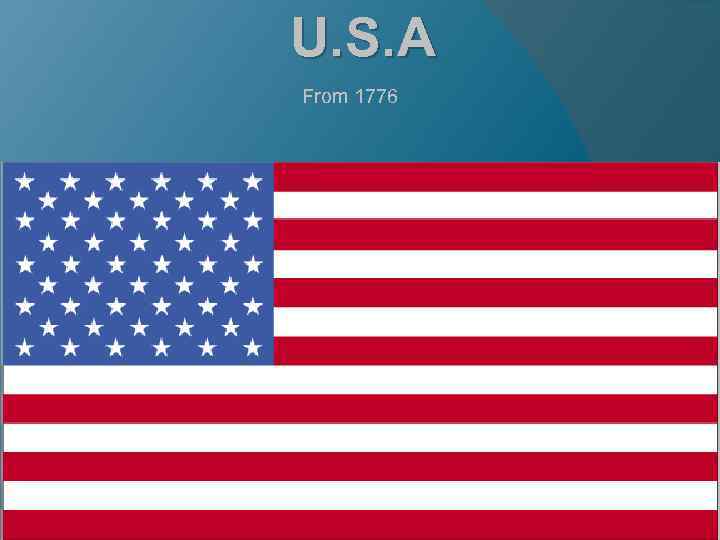 U. S. A From 1776
U. S. A From 1776
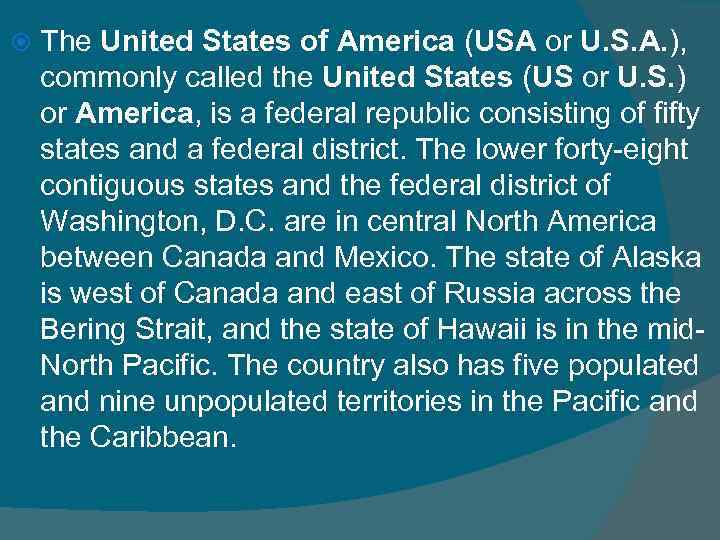 The United States of America (USA or U. S. A. ), commonly called the United States (US or U. S. ) or America, is a federal republic consisting of fifty states and a federal district. The lower forty-eight contiguous states and the federal district of Washington, D. C. are in central North America between Canada and Mexico. The state of Alaska is west of Canada and east of Russia across the Bering Strait, and the state of Hawaii is in the mid. North Pacific. The country also has five populated and nine unpopulated territories in the Pacific and the Caribbean.
The United States of America (USA or U. S. A. ), commonly called the United States (US or U. S. ) or America, is a federal republic consisting of fifty states and a federal district. The lower forty-eight contiguous states and the federal district of Washington, D. C. are in central North America between Canada and Mexico. The state of Alaska is west of Canada and east of Russia across the Bering Strait, and the state of Hawaii is in the mid. North Pacific. The country also has five populated and nine unpopulated territories in the Pacific and the Caribbean.
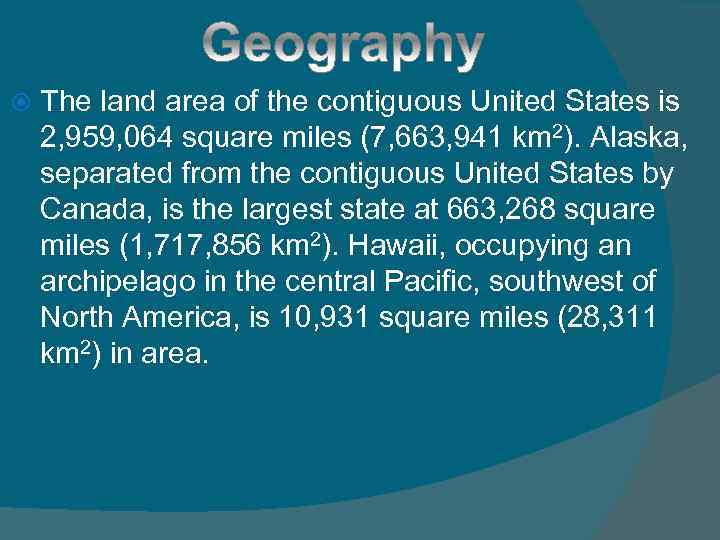 The land area of the contiguous United States is 2, 959, 064 square miles (7, 663, 941 km 2). Alaska, separated from the contiguous United States by Canada, is the largest state at 663, 268 square miles (1, 717, 856 km 2). Hawaii, occupying an archipelago in the central Pacific, southwest of North America, is 10, 931 square miles (28, 311 km 2) in area.
The land area of the contiguous United States is 2, 959, 064 square miles (7, 663, 941 km 2). Alaska, separated from the contiguous United States by Canada, is the largest state at 663, 268 square miles (1, 717, 856 km 2). Hawaii, occupying an archipelago in the central Pacific, southwest of North America, is 10, 931 square miles (28, 311 km 2) in area.
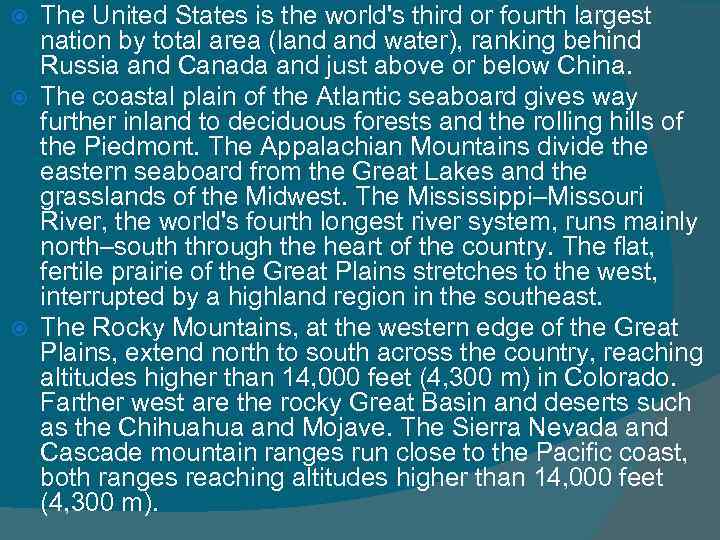 The United States is the world's third or fourth largest nation by total area (land water), ranking behind Russia and Canada and just above or below China. The coastal plain of the Atlantic seaboard gives way further inland to deciduous forests and the rolling hills of the Piedmont. The Appalachian Mountains divide the eastern seaboard from the Great Lakes and the grasslands of the Midwest. The Mississippi–Missouri River, the world's fourth longest river system, runs mainly north–south through the heart of the country. The flat, fertile prairie of the Great Plains stretches to the west, interrupted by a highland region in the southeast. The Rocky Mountains, at the western edge of the Great Plains, extend north to south across the country, reaching altitudes higher than 14, 000 feet (4, 300 m) in Colorado. Farther west are the rocky Great Basin and deserts such as the Chihuahua and Mojave. The Sierra Nevada and Cascade mountain ranges run close to the Pacific coast, both ranges reaching altitudes higher than 14, 000 feet (4, 300 m).
The United States is the world's third or fourth largest nation by total area (land water), ranking behind Russia and Canada and just above or below China. The coastal plain of the Atlantic seaboard gives way further inland to deciduous forests and the rolling hills of the Piedmont. The Appalachian Mountains divide the eastern seaboard from the Great Lakes and the grasslands of the Midwest. The Mississippi–Missouri River, the world's fourth longest river system, runs mainly north–south through the heart of the country. The flat, fertile prairie of the Great Plains stretches to the west, interrupted by a highland region in the southeast. The Rocky Mountains, at the western edge of the Great Plains, extend north to south across the country, reaching altitudes higher than 14, 000 feet (4, 300 m) in Colorado. Farther west are the rocky Great Basin and deserts such as the Chihuahua and Mojave. The Sierra Nevada and Cascade mountain ranges run close to the Pacific coast, both ranges reaching altitudes higher than 14, 000 feet (4, 300 m).
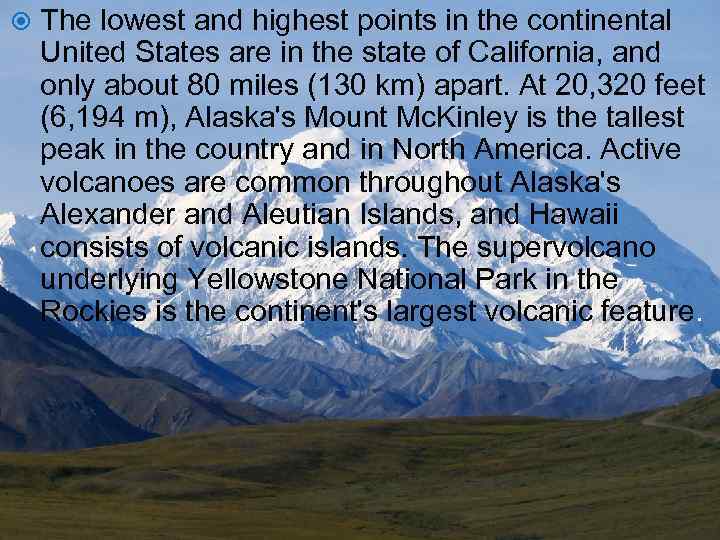 The lowest and highest points in the continental United States are in the state of California, and only about 80 miles (130 km) apart. At 20, 320 feet (6, 194 m), Alaska's Mount Mc. Kinley is the tallest peak in the country and in North America. Active volcanoes are common throughout Alaska's Alexander and Aleutian Islands, and Hawaii consists of volcanic islands. The supervolcano underlying Yellowstone National Park in the Rockies is the continent's largest volcanic feature.
The lowest and highest points in the continental United States are in the state of California, and only about 80 miles (130 km) apart. At 20, 320 feet (6, 194 m), Alaska's Mount Mc. Kinley is the tallest peak in the country and in North America. Active volcanoes are common throughout Alaska's Alexander and Aleutian Islands, and Hawaii consists of volcanic islands. The supervolcano underlying Yellowstone National Park in the Rockies is the continent's largest volcanic feature.
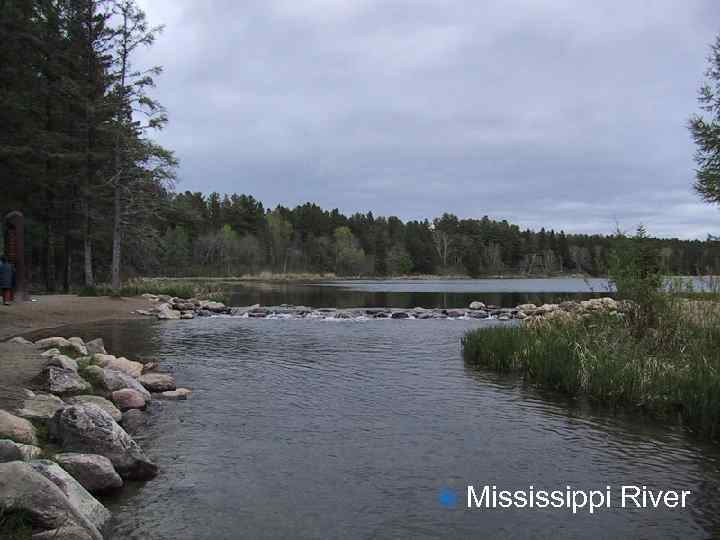 Mississippi River
Mississippi River
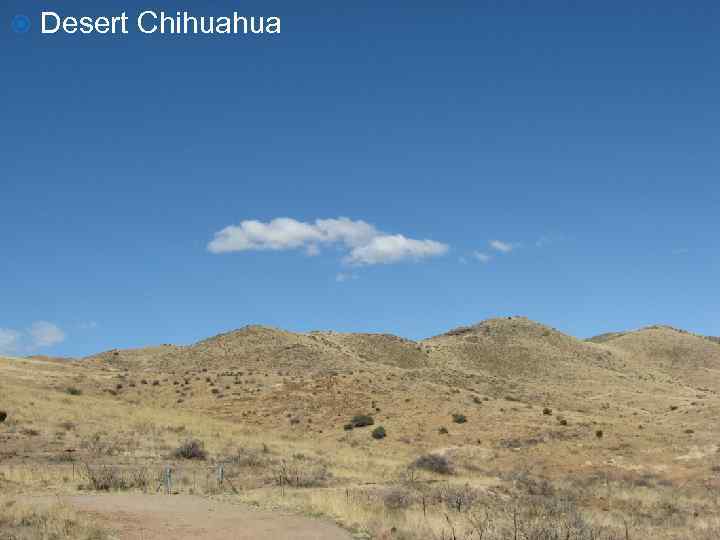 Desert Chihuahua
Desert Chihuahua
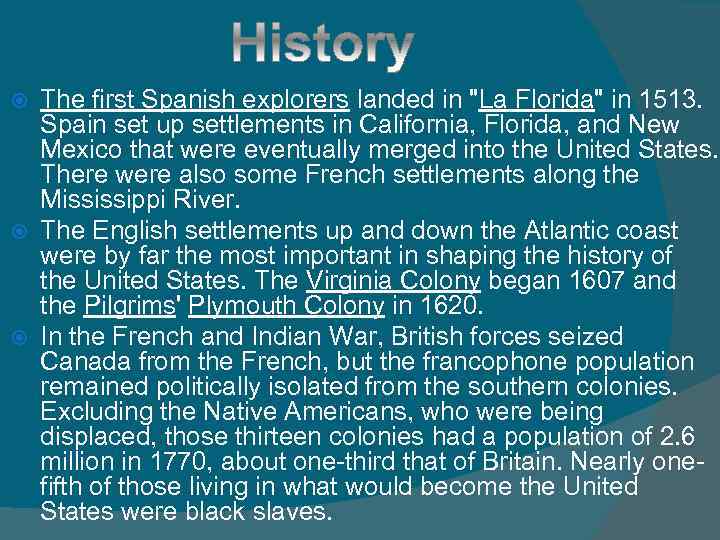 The first Spanish explorers landed in "La Florida" in 1513. Spain set up settlements in California, Florida, and New Mexico that were eventually merged into the United States. There were also some French settlements along the Mississippi River. The English settlements up and down the Atlantic coast were by far the most important in shaping the history of the United States. The Virginia Colony began 1607 and the Pilgrims' Plymouth Colony in 1620. In the French and Indian War, British forces seized Canada from the French, but the francophone population remained politically isolated from the southern colonies. Excluding the Native Americans, who were being displaced, those thirteen colonies had a population of 2. 6 million in 1770, about one-third that of Britain. Nearly onefifth of those living in what would become the United States were black slaves.
The first Spanish explorers landed in "La Florida" in 1513. Spain set up settlements in California, Florida, and New Mexico that were eventually merged into the United States. There were also some French settlements along the Mississippi River. The English settlements up and down the Atlantic coast were by far the most important in shaping the history of the United States. The Virginia Colony began 1607 and the Pilgrims' Plymouth Colony in 1620. In the French and Indian War, British forces seized Canada from the French, but the francophone population remained politically isolated from the southern colonies. Excluding the Native Americans, who were being displaced, those thirteen colonies had a population of 2. 6 million in 1770, about one-third that of Britain. Nearly onefifth of those living in what would become the United States were black slaves.
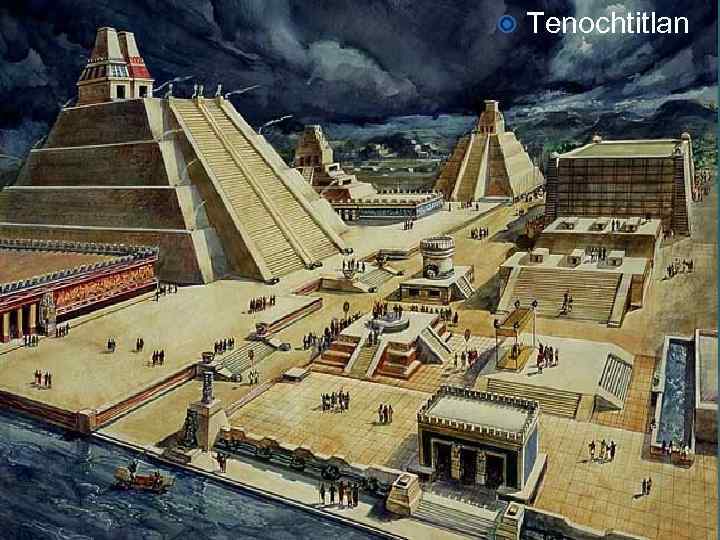 Tenochtitlan
Tenochtitlan
 Independence and expansion The American Revolution was the first successful colonial war of independence against a European power. Americans had developed a democratic system of local government and an ideology of "republicanism“ that held government rested on the will of the people (not the king), which strongly opposed corruption and demanded civic virtue. They demanded their rights as Englishmen and rejected British efforts to impose taxes without the approval of colonial legislatures. The British insisted and the conflict escalated to full-scale war in 1775, the American Revolutionary War. On June 14, 1775, the Continental Congress, convening in Philadelphia, established a Continental Army under the command of George Washington. Proclaiming that "all men are created equal" and endowed with "certain unalienable Rights", the Congress adopted the Declaration of Independence, drafted largely by Thomas Jefferson, on July 4, 1776. That date is now celebrated annually as America's Independence Day. In 1777, the Articles of Confederation established a weak government that operated until 1789.
Independence and expansion The American Revolution was the first successful colonial war of independence against a European power. Americans had developed a democratic system of local government and an ideology of "republicanism“ that held government rested on the will of the people (not the king), which strongly opposed corruption and demanded civic virtue. They demanded their rights as Englishmen and rejected British efforts to impose taxes without the approval of colonial legislatures. The British insisted and the conflict escalated to full-scale war in 1775, the American Revolutionary War. On June 14, 1775, the Continental Congress, convening in Philadelphia, established a Continental Army under the command of George Washington. Proclaiming that "all men are created equal" and endowed with "certain unalienable Rights", the Congress adopted the Declaration of Independence, drafted largely by Thomas Jefferson, on July 4, 1776. That date is now celebrated annually as America's Independence Day. In 1777, the Articles of Confederation established a weak government that operated until 1789.


